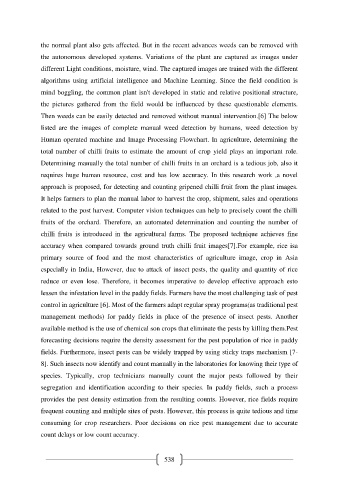Page 548 - e-Book
P. 548
the normal plant also gets affected. But in the recent advances weeds can be removed with
the autonomous developed systems. Variations of the plant are captured as images under
different Light conditions, moisture, wind. The captured images are trained with the different
algorithms using artificial intelligence and Machine Learning. Since the field condition is
mind boggling, the common plant isn't developed in static and relative positional structure,
the pictures gathered from the field would be influenced by these questionable elements.
Then weeds can be easily detected and removed without manual intervention.[6] The below
listed are the images of complete manual weed detection by humans, weed detection by
Human operated machine and Image Processing Flowchart. In agriculture, determining the
total number of chilli fruits to estimate the amount of crop yield plays an important role.
Determining manually the total number of chilli fruits in an orchard is a tedious job, also it
requires huge human resource, cost and has low accuracy. In this research work ,a novel
approach is proposed, for detecting and counting gripened chilli fruit from the plant images.
It helps farmers to plan the manual labor to harvest the crop, shipment, sales and operations
related to the post harvest. Computer vision techniques can help to precisely count the chilli
fruits of the orchard. Therefore, an automated determination and counting the number of
chilli fruits is introduced in the agricultural farms. The proposed technique achieves fine
accuracy when compared towards ground truth chilli fruit images[7].For example, rice isa
primary source of food and the most characteristics of agriculture image, crop in Asia
especially in India, However, due to attack of insect pests, the quality and quantity of rice
reduce or even lose. Therefore, it becomes imperative to develop effective approach esto
lessen the infestation level in the paddy fields. Farmers have the most challenging task of pest
control in agriculture [6]. Most of the farmers adapt regular spray programs(as traditional pest
management methods) for paddy fields in place of the presence of insect pests. Another
available method is the use of chemical son crops that eliminate the pests by killing them.Pest
forecasting decisions require the density assessment for the pest population of rice in paddy
fields. Furthermore, insect pests can be widely trapped by using sticky traps mechanism [7-
8]. Such insects now identify and count manually in the laboratories for knowing their type of
species. Typically, crop technicians manually count the major pests followed by their
segregation and identification according to their species. In paddy fields, such a process
provides the pest density estimation from the resulting counts. However, rice fields require
frequent counting and multiple sites of pests. However, this process is quite tedious and time
consuming for crop researchers. Poor decisions on rice pest management due to accurate
count delays or low count accuracy.
538

